How to Design and Install an Off-Grid Solar System
How to Design and Install an Off-Grid Solar System
As the price of silicon material continues to decline, the cost of photovoltaic modules also continues to decrease; At the same time, the price of energy storage batteries is also decreasing, which greatly stimulates the demand for downstream applications. Whether it is a household off grid power generation system or a industry and commercial off grid solar power system, there is great demand potential and growth space.
At present, there are still many countries and regions around the world, such as islands and remote areas, with incomplete power grid systems and no grid access. Or even if there is a power grid in some areas, the electricity price is very expensive due to the Energy crisis. However, many countries and regions have abundant solar energy and long daily lighting hours, making it particularly suitable for developing off grid solar power generation systems.
Off-grid solar systems are a great way to generate your own electricity and reduce your reliance on the grid. Which mainly including: 1solar panel 2 solar charge controller 3 off grid solar inverter 4 energy storage battery However, designing and installing an off-grid solar system can be a complex process. Here are a few tips to help you get started:
1. Determine your energy needs
The first step is to determine how much electricity you need to power your home or business. You can do this by looking at your past electricity bills. Or check the loads (AC,TV ,lamps,) to calculate how much (KW)electricity you use in a day totally.
The following formula can be used to calculate the power consumption of electrical appliances:Power consumption (kWh)=power (kW) × Usage time ( h)
Firstly, determine the power of the electrical appliance (in kilowatts, kW). The power can be found in the identification or technical specifications of the electrical appliance itself. If there is only current (in amperes, A) and voltage (in volts, V), the following formula can be used to calculate power:
Power (kW, kW)=Current (Amperes, A) × Voltage (volts, V)/1000
Then, determine the time to use the electrical appliance (in hours, h). This refers to the operating time of an electrical appliance within a specific time period, which can be estimated or recorded based on actual usage.
Finally, insert the power and usage time into the formula to calculate the power consumption. Multiplying the power by the usage time can obtain the result of power consumption, in kilowatt hours (kWh).
Once you know how much (KW)electricity you use, you can start to size your solar system.
As the top Five off grid solar power System supplier ,Lersion offer one stop solar system solution for household, industrial & commercial purpose , we can produce full series 1-300 KW off grid solar inverter.
2. Choose the right solar panels
There are a number of different solar panel brands and models available on the market. It's important to choose solar panels that are right for your needs. Some factors to consider include the size of the panels, the efficiency of the panels, and the warranty. Lersion solar,being one of partner of LONGI etc, can offer many first tier brands solar panel at very competitive price.![]()
3. Choose the right batteries
Solar panels generate electricity during the day, but you need a way to store that electricity so you can use it at night or on cloudy days. Batteries are the most common way to store solar energy. When choosing batteries, you need to consider the size of the batteries, the capacity of the batteries, and the lifespan of the batteries.
Lersion factory produce batteries by ourselves , including gel battery and lithium battery (LiFePO4). As LiFePO4 & Gel battery Expert, character by *Grade A Lithium Battery*Long cycle life >6000 cycles*High Efficiency & Fast Charging*Compatible with Various Inverters*Intelligent Battery Management System
4. Choose the right charge controller
A charge controller is a device that regulates the flow of electricity from the solar panels to the batteries. It's important to choose a charge controller that is right for your system. Some factors to consider include the size of the charge controller, the voltage of the charge controller, and the amperage of the charge controller. Lersion is charge controller factory supplier .
5. Choose the right inverter
An inverter is a device that converts the direct current (DC) electricity from the batteries to the alternating current (AC) electricity that most appliances use. It's important to choose an inverter that is right for your system. Some factors to consider include the size of the inverter, the voltage of the inverter, and the amperage of the inverter.
Lersion 1-300KW Off Grid Solar Inverter ,with Germany Infineon IGBT Module ,America DSP Chip technology, color touch screen *More Stable *More Durable*More Safe* High End.
6. Install your solar system
Once you've chosen all of your components, it's time to install your solar system. The installation process can be complex, so it's a good idea to hire a professional solar installer.
7. Operate and maintain your solar system
Once your solar system is installed, you need to operate and maintain it properly. This includes cleaning the solar panels regularly, checking the batteries for leaks, and monitoring the performance of your system.
Here are some additional tips for designing and installing an off-grid solar system:
Consider the amount of sunlight your home or business receives. Solar panels need direct sunlight to generate electricity. If your home or business doesn't receive a lot of sunlight, you may need to size your system larger or consider a different type of solar panel.
Think about your future energy needs. If you plan on adding solar panels to your home or business, it's important to think about your future energy needs. If you plan on adding an electric car or upgrading your appliances, you may need to size your system larger.
Get professional help. If you're not sure how to design and install an off-grid solar system, it's a good idea to get professional help. A solar installer can help you determine your energy needs, size your system, and install your system.
By following these tips, you can design and install an off-grid solar system that will provide you with reliable power for many years to come.
